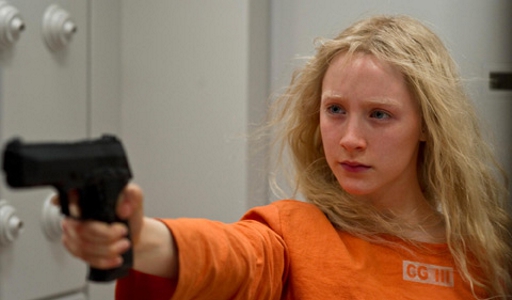
Can a teenage girl take out skinhead hitmen and CIA operatives? That’s the question posed by the newest girl-fighter film, HANNA, opening April 8, 2011. HANNA debuts at an unpropitious time. Two weeks prior, girl fighters were spotlighted in the bombastic Zack Snyder film, SUCKER PUNCH. However, given that HANNA is about a girl trained by her father, more fans are citing Chloe Moretz’s performance as Hit Girl in last year’s KICK-ASS. Both comparisons are completely unfair. HANNA works on a totally different level than those other films. It reunites Academy-Award-nominated teen actress Saoirse Ronan with Golden-Globe-nominated director Joe Wright, who previously worked together in the critically-acclaimed 2007 film ATONEMENT. What’s more, Academy-Award-winner Cate Blanchett plays Hanna’s nemesis, delivering what may well be her finest villainess portrayal to date. Filmed on location in Berlin, Finland and Morocco, HANNA is a part international spy thriller, part Grimm fairy tale, part girl-coming-of-age, and all girl empowerment.
With a distinctive Euro-film style, HANNA is an action-packed trip down the rabbit hole set to the trance-inducing soundtrack of the Chemical Brothers.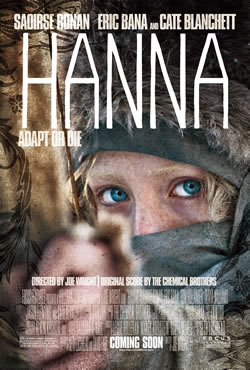 Both SUCKER PUNCH and KICK-ASS had fantasy elements from the start, especially with the fetishist costumes. HANNA is set in the real modern world, but it is as much a fantasy as the others. Wright explains, “I’m not that interested in the science of the movie and I think that possibly shows in the wafer-thin explanation of it. The original screenplay by Seth Lochhead was completely without explanation. Then later, before I came on board, subsequent drafts where done where it became more of a kind of procedural story that involved CIA and espionage and back stories – everyone had a what and why. When I came on board, I tried to take it much further towards Seth’s original idea that the whole thing was kind of completely unexplained really. I think it’s interesting, the kind of development of storytelling from Hitchcock’s theories on the Mcguffin to David Lynch’s complete refusal to actually give any reasoning for his plot other than poetic proof. So it kind of fits somewhere in that line. All my work I consider to be an exercise. I never think that I’m creating a definitive film or that this is the film that is me. If I start thinking like that, then I’ll just screw myself, so each one is a development and part of a longer process. So I was experimenting with ideas of Mcguffin and how much you give away and how much you don’t give away and stuff like that.” Wright cites Lynch’s BLUE VELVET (1986) as a personal turning point film for him – the film “that changed everything.”
Both SUCKER PUNCH and KICK-ASS had fantasy elements from the start, especially with the fetishist costumes. HANNA is set in the real modern world, but it is as much a fantasy as the others. Wright explains, “I’m not that interested in the science of the movie and I think that possibly shows in the wafer-thin explanation of it. The original screenplay by Seth Lochhead was completely without explanation. Then later, before I came on board, subsequent drafts where done where it became more of a kind of procedural story that involved CIA and espionage and back stories – everyone had a what and why. When I came on board, I tried to take it much further towards Seth’s original idea that the whole thing was kind of completely unexplained really. I think it’s interesting, the kind of development of storytelling from Hitchcock’s theories on the Mcguffin to David Lynch’s complete refusal to actually give any reasoning for his plot other than poetic proof. So it kind of fits somewhere in that line. All my work I consider to be an exercise. I never think that I’m creating a definitive film or that this is the film that is me. If I start thinking like that, then I’ll just screw myself, so each one is a development and part of a longer process. So I was experimenting with ideas of Mcguffin and how much you give away and how much you don’t give away and stuff like that.” Wright cites Lynch’s BLUE VELVET (1986) as a personal turning point film for him – the film “that changed everything.”
Beyond being an overt spy thriller, HANNA gives several nods to fairy tale elements, amplified by the journey of the title character. Saoirse Ronan (pronounced Sir-Shah) has an ethereal light behind her eyes, one that would have made her a far stronger Alice than Mia Wasikowska in the recent ALICE IN WONDERLAND (2010). According to Ronan, “When we were making the film, the whole point was to make it surreal and magical.” Wright echoes this notion, “There was a kind of fairy tale structure to it, which was the kid grows up in the safety of a parental environment, needs to leave that environment, go on a journey, encounter darkness, overcome it, but at a cost. That’s kind of a fairy tale structure, so it was implicit in the script but not necessarily explicit, although the opening 15-20 pages certainly had a kind of fairy tale atmosphere – a cabin in the woods and all this kind of stuff. So I just made all of that more explicit. I was interested in playing with archetypes and the film existing in a kind of dreamlike plane, and therefore using fairy tale to access certain common themes and images.”
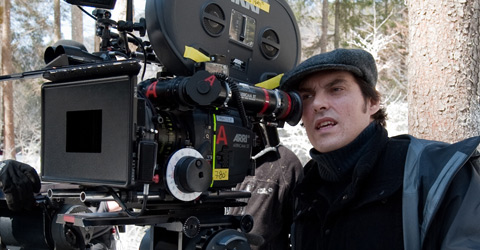
But given that this is a KungFuMagazine.com review, it’s the fight scenes that are of the most interest. At 5′ 6″ and 16 years of age, Ronan is surprisingly convincing fighting off fully grown assailants. In SUCKER PUNCH and KICK-ASS, it was easy to park your brain outside and suspend belief for the fights. There must be suspension of belief for any fight scene that includes an aerial or a barrel-roll. In contrast, HANNA manages believable girl fights without the spandex and lingerie. Ironically, that wasn’t the intention, at least according to Wright, “I didn’t really try to make it [the violence] real to be honest with you. I tried to make it quite sensational – because it’s not real. It’s a fairy tale and fairy tales are dark and they’re very violent. As I’m sure you know, in Han Christian Anderson’s Little Mermaid, she commits suicide. Hansel and Gretel get an old woman and put her in an oven and cook her alive. The whole point about fairy tales is that their dark. They’ve been colonized by Disney and children. And they’re lied to and told that everything’s going to be happy ever after. The point of fairy tales is to prepare children with the fact that they are going to come up against some cruelty and some deceit and some darkness in the world. That’s their purpose, I think really.”
The fights were choreographed by Jeff Imada, a veteran martial arts master who has tallied up an impressive filmography of work over the last three decades including two installments of the BOURNE franchise (2004 & 2007), BOOK OF ELI (2010) and most recently, GREEN HORNET. Ronan gushes over Imada, “He is god, as I’m sure you know. He’s Danny Inosanto’s right-hand man. That’s actually where I trained for a couple of weeks – in the Inosanto Academy. It was lots of fun… It was a mix style really. It was individual. It was basically designed for Hanna because the majority of the people she fought were men. And so I needed to use their energy and strength against them. Honestly, I’m not quite sure what the style was.” Ronan is eager to keep her training up, but hasn’t had the opportunity with her busy film schedule. “I trained in the gym for about two hours a day for about two months. And suddenly I had muscles, didn’t I? I felt like a boy. I had all these muscles and I didn’t like them, but I felt stronger. My core felt stronger too, which was a great feeling. I did stick fighting, which we actually see at the start of the film. Eric [Bana] and I do that. And that’s actually quite a complicated thing to do. We learned how to make fires and bow and arrow training and all that.”
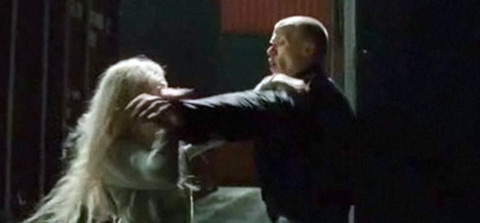
For Wright, working with Imada was a perfect fit as the fight must express the character. Together, Imada, Wright and Ronan focused on developing techniques that were true the Hanna’s character. Wright elaborates, “What I really enjoyed about working with Jeff is that the small amount of fight stuff I’ve done before, they just kind of impose a style on the character that’s got nothing to do with the character. With this, as Saoirse suggests, by talking about the balancing, using the men’s strength against them, it was all about finding the character through her fighting style and the fighting style through her character. So when we started, we weren’t just looking at punches and moves and that kind of stuff. We were looking at Hanna, who she was, how she might move as a human being.”
“I think Hanna is someone who’s always very focused,” adds Ronan, “whether it be on her fascination with everything that’s new to her and I feel like only when she starts to fight, only when that switch is flipped, that’s when she turns into an animal. We really did treat her like an animal – like a wolf. So I don’t know how a balance both. Really, for me, it was about instinct and being able to, well, basically wipe your memory of anything that has really ever happened or anything that you’ve ever really experienced because she’s never experienced anything, really, I don’t think. So everything seemed quite beautiful and quite wonderful. We did this one shot in Morocco in front of a hotel and there were camels and musicians and lots of Moroccan natives. I stepped out of the bushes. We did it in a steady-cam shot and it was amazing. And suddenly this whole world just opened up and it was like I saw it for the first time. Maybe it was the third take or so, but I got to have those kinds of experiences myself in the film.
The single shot is becoming a signature trademark of Wright’s filmmaking. ATONEMENT contained an amazing single shot of troops assembled on the beach. HANNA also contains a swirling single shot from the airport to the subway to a tightly choreographed fight scene. It is masterful filmmaking and Wright confesses he wasn’t planning to do it. “I was really determined not to do any single takes in this film and it’s something that just kind of happens really as I’m developing the shooting script. And often it’s because of necessity. The underground fight – and this one for instance – was done because normally a scene like that as written would take about forty set-ups. That would take me about three days and I only had one day to shoot the scene. It was made on quite a small budget, this movie, for an action film. I know I can do a single take. Whether or not I can do it is a kind of gamble – a few rehearsals and get five or six takes at the end of the day. So you’re kind of gambling on that one day working and if it does work, then you’ve accomplished what you’ve needed to accomplish in a single day. There’s also kind of theatricality to it I like. It’s a kind of showmanship. It’s always a good day when you’re doing one of those shots… if you get it. If you don’t, it’s a f***ing disaster.”
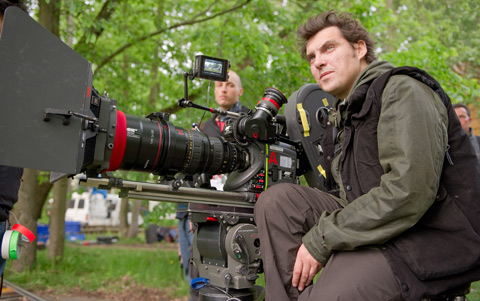
turn given her previous work. Ironically, she also plays an assassin in her next film, VIOLET & DAISY, currently slated for release in 2011. “She’s not the same kind of killer at all. I don’t want to give away the story or anything, but she’s not really a killer – Daisy isn’t – certainly not a natural one like Hanna. And it’s quite funny. It’s a black comedy. This isn’t a black comedy. I’m just going to stick to assassins and branch out within the assassin world (laughs).”
Pleased to be part of rising bevy of girl fighters in film, Ronan believes that it is indicative of what film audiences want now – girls who are strong and can kick ass. “I went a screening the other night, which Joe wasn’t allowed to go to because it was an ‘all girls’ screening. And there were women, some of them were mothers, they were all in their late 30s. And what they really got out of the film was a sense of empowerment and the fact that not even that she’s young, but that she’s female and has this strength over so many people. It’s very exciting to see on screen. And I’m glad now that there’s more characters coming out.”
“It’ll be great when Katniss from the HUNGER GAMES (slated for 2012) comes out at well. Not to go on to a different film, but I remember reading the book and thinking that this is a character that girls are going to look up to. And I think they’re going to do the same with HANNA as well. The reason why I did was because she’s weird. She’s a bit of a misfit and she’s got strength.”
Written by Gene Ching for KUNGFUMAGAZINE.COM
COPYRIGHT KUNGFUMAGAZINE.COM, ALL RIGHTS RESERVED.





